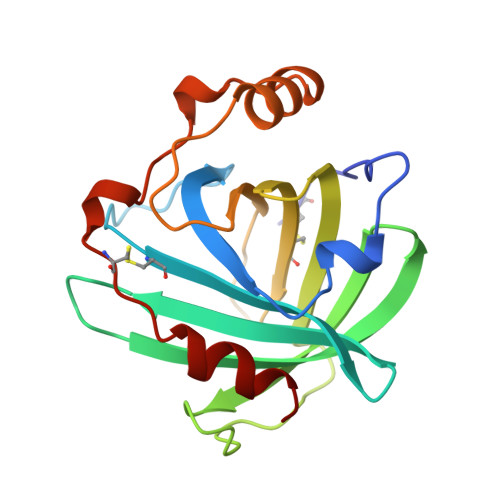The crystal structure of nitrophorin 4 at 1.5 A resolution: transport of nitric oxide by a lipocalin-based heme protein.
Andersen, J.F., Weichsel, A., Balfour, C.A., Champagne, D.E., Montfort, W.R.(1998) Structure 6: 1315-1327
- PubMed: 9782054
- DOI: https://doi.org/10.1016/s0969-2126(98)00131-2
- Primary Citation of Related Structures:
1NP4 - PubMed Abstract:
Nitrophorins are nitric oxide (NO) transport proteins from the saliva of blood-feeding insects, which act as vasodilators and anti-platelet agents. Rhodnius prolixus, an insect that carries the trypanosome that causes Chagas' disease, releases four NO-loaded nitrophorins during blood feeding, whereupon the ligand is released into the bloodstream or surrounding tissue of the host. Histamine, a signaling molecule released by the host upon tissue damage, is tightly bound by the nitrophorins; this may facilitate the release of NO and reduce inflammation in the host. Recombinant nitrophorin 4 (NP4) was expressed in Escherichia coli, reconstituted with heme, and found to bind NO and histamine in a manner similar to that of the natural protein. The crystal structure of NP4 revealed a lipocalin-like eight-stranded beta barrel, with heme inserted into one end of the barrel. His59 ligates the proximal site on the heme, a solvent molecule (NH3) ligates the distal site, and three additional solvent molecules occupy the distal pocket. Buried in the protein interior are Glu55 and three solvent molecules. A detailed comparison with other lipocalins suggests that NP4 is closely related to the biliverdin-binding proteins from insects. The nitrophorins have a unique hemoprotein structure and are completely unlike the globins, the only other hemoproteins designed to transport dissolved gases. Compared with the recently described structure of NP1, the NP4 structure is considerably higher resolution, confirms the unusual placement of ionizable groups in the protein interior, and clarifies the solvent arrangement in the distal pocket. It also provides a striking example of structural homology where sequence homology is minimal.
- Department of Biochemistry University of Arizona Tucson, AZ 85721, USA.
Organizational Affiliation:


















